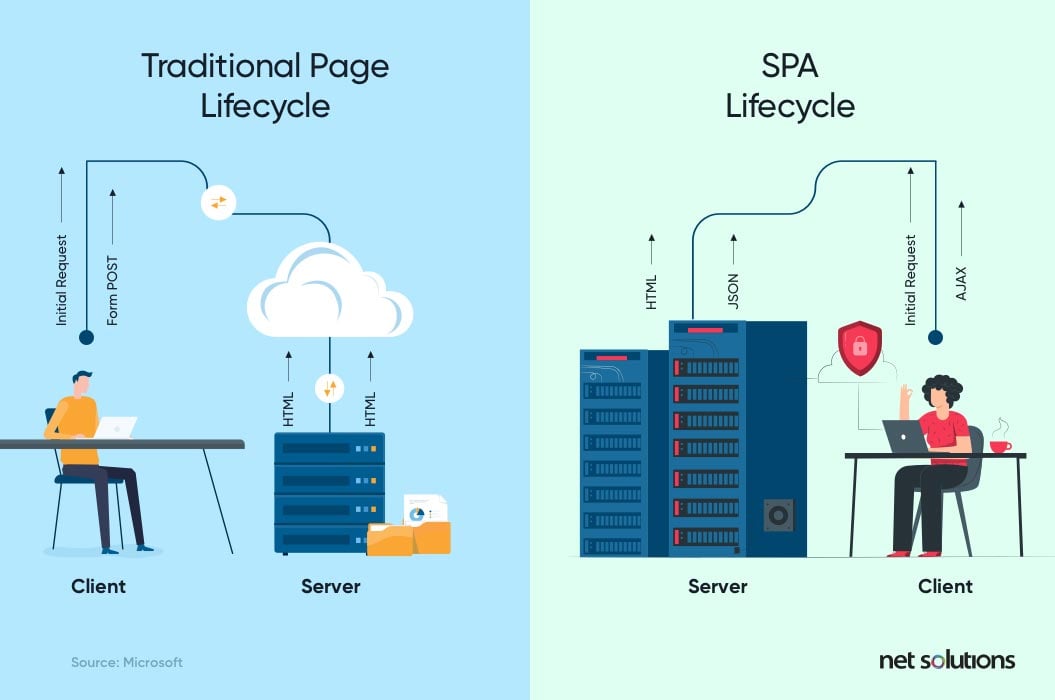You might have heard about Single Page Applications (SPAs) and wondered if they’re the right fit for your business. Are they as efficient and user-friendly as claimed? Do they suit your specific needs? This guide will try to answer these questions. We’ll explain what SPAs are, how they work, and determine if they are the solution to the challenges your business is facing.
What Are Single Page Applications?
A Single Page Application (SPA) is a web application (or website) that, when interacting with the user, rewrites the current page (versus loading entire new pages from the server). That is, the application behaves more like a desktop app in a web browser.
Many businesses today turn to an experienced front-end development company to order a custom SPA. Why? Well, the magic of SPAs lies in their core design. They load all necessary HTML, CSS, and scripts upon the initial load, or progressively as needed. This means after the first page loads, all interactions happen instantly without reloading or navigating to other pages.
Technologies like AJAX and frameworks such as AngularJS, ReactJS, or Vue.js are typically employed to handle data and display it without page refreshes. This is ideal for creating fluid, high-performance applications.
6 Common Types of SPAs
#1 Consumer-Facing Portals
Think of e-commerce sites, where user experience impacts sales. SPAs allow customers to filter, sort, and view products without page refreshes. For instance, when a customer adjusts a price filter, the product listings update in real time without any perceptible delay.
#2 Dashboard Applications
These are used primarily for services that require real-time data updates, such as analytics or financial monitoring platforms. Users benefit from such SPAs as they can interact with different sets of data, like charts or graphs, seamlessly. Changes and updates occur in real time.
#3 Interactive Educational Platforms
SPAs shine in online education. They keep everything from video lessons to quizzes running smoothly on one page. This setup keeps students engaged, preventing distractions that come from page reloads.
#4 Project Management Tools
Quick updates and seamless transitions between tasks are what we long for in project management. SPAs allow team members to update statuses, add comments, and track progress without refreshing the page.
#5 Health and Fitness Apps
In fitness apps, immediate feedback is key. SPAs excel here by updating workout progress, nutrition logs, and other health metrics instantly. This is perfect for real-time health monitoring and active lifestyle management, such as daily fitness tracking or meal planning.
#6 Event and Booking Systems
SPAs streamline the booking experience, too. Users can perform tasks like checking availability and confirming reservations without disruptions. This significantly enhances the user experience and increases the likelihood of completed bookings.
Pros & Cons of SPAs
So are SPAs a must-have? Not really. Rather, they are solutions perfect for particular scenarios. Here’s a quick overview of where they shine and what limitations they have.
| PROS | CONS |
| Smooth transitions and immediate responsiveness enhance user satisfaction.Since most resources are loaded once at the start, there’s less demand on the server for constant reloads, which can reduce hosting costs and server-side load.State management is simplified as everything happens within a single page, making it easier to debug and manage. | Search engines have traditionally had difficulty indexing SPA content fully (though advances in technology are reducing this issue).The first load may require more time as the application needs to fetch sizable files initially.Users with JavaScript disabled won’t be able to use SPAs, which can limit accessibility. |
Who Needs SPAs, Then?
On balance, SPAs fit perfectly where any delay or page reload could disrupt the user’s flow and where constant engagement is critical. They’re ideal for companies where users need to process or interact with information in real time, like adjusting a complex graphic design or tweaking a digital marketing campaign on the fly.
Start-ups focusing on digital products should seriously consider SPAs, too. The latter can handle everything from updates to user interactions without a hiccup. Imagine a user entering data into an online project management tool. SPAs make it possible to add, edit, and move tasks around without ever leaving the page.
Besides, any platform that’s all about “the experience” — like online education portals or media libraries — also stands to gain. Here, SPAs can keep users hooked by providing a video stream, quiz, or interactive lesson without pauses or reloads. They just mimic the dynamic flow of standalone applications.
Final Thoughts
All In all, Single Page Applications are particularly advantageous for projects where user engagement and real-time interactions are critical. However, the decision to use them should consider both the nature of your project and the technical challenges they pose.




